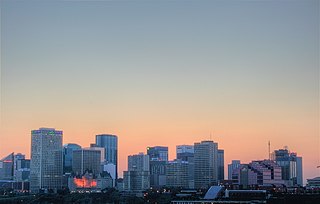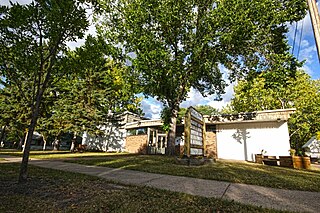
Strathearn is a roughly triangular shaped residential neighbourhood in south central Edmonton, Alberta, Canada. Most of the development in Strathearn dates to the 1940s and 1950s.

Garneau is one of the oldest neighbourhoods in the city of Edmonton, Canada. Prior to 1912, it was part of the City of Strathcona. It is named after one of its first inhabitants, Laurent Garneau, a former Manitoba Métis rebel and Hudson's Bay Company employee who with his wife and family settled there around 1874.
Strathcona is a residential neighbourhood in south central Edmonton, Alberta, Canada. It is a part of, and should not be confused with, Old Strathcona, although much of the Strathcona neighbourhood is in Old Strathcona. The neighbourhood overlooks both the North Saskatchewan River and the Mill Creek Ravine.
Eastwood is a residential neighbourhood in north central Edmonton, Alberta, Canada. It is one of Edmonton's older neighbourhoods, with development starting in 1906. Today, most of the residential construction (88%) dates from after World War II.
Westmount is an established central-west residential neighbourhood in Edmonton, Alberta, Canada. It is geographically close to the downtown core.

Idylwylde is a residential neighbourhood in south east Edmonton, Alberta, Canada.
Kenilworth is a residential neighbourhood in south east Edmonton, Alberta, Canada located just to the north of Whyte Avenue.
Terrace Heights is a roughly triangle-shaped residential neighbourhood in south east Edmonton, Alberta, Canada.
Newton is a residential neighbourhood located in north east Edmonton, Alberta, Canada. It is named for Reverend William Newton who arrived in Edmonton in 1875. The Anglican canon served the people of Edmonton until 1900. The Hermitage, a hospital he founded just east of the old town, is now the Hermitage area of Edmonton. The neighbourhoods of Newton and Canon are named after him.
Allendale is a residential neighbourhood located in south west Edmonton, Alberta, Canada. The neighbourhood is named for the Allen family, who owned a farm there. It was annexed by the City of Strathcona in 1907.
North Glenora is a residential neighbourhood in west Edmonton, Alberta, Canada. The neighbourhood is bounded on the north by 111 Avenue, on the south by 107 Avenue, on the east by Groat Road, and on the west by 142 Street. Groat Road provides access to locations on the south side, including the University of Alberta and Whyte Avenue.
Pleasantview is a residential neighbourhood in south west Edmonton, Alberta, Canada.
Balwin is a residential neighbourhood in north east Edmonton, Alberta, Canada. Originally part of North Edmonton, the area was annexed by the City of Edmonton in 1912.

Ritchie is a residential neighbourhood in south east Edmonton, Alberta, Canada. It is named for Robert Ritchie, the original owner of the Ritchie Mill and former mayor of the City of Strathcona. The population of Ritchie enjoy good access to the nightlife of nearby Old Strathcona and the Mill Creek Ravine.
Empire Park is a residential neighbourhood in southwest Edmonton, Alberta, Canada. A major shopping centre, Southgate Centre, is located at the west end of the Neighbourhood.
King Edward Park is a residential neighbourhood on south east Edmonton, Alberta, Canada. The neighbourhood was originally annexed by Edmonton in 1912.
Rosslyn is a residential neighbourhood in north west Edmonton, Alberta, Canada. The neighbourhood has good access to shopping services at Northgate Centre and North Town Mall.

Prince Charles is a residential neighbourhood in north west Edmonton, Alberta. The area was named in honour of Charles III, then known as Prince Charles.
Killarney is a residential neighbourhood located in north east Edmonton, Alberta, Canada. While the area became part of Edmonton in 1913, residential development did not occur until the 1950s and 1960s.
Rideau Park is a residential neighbourhood in southwest Edmonton, Alberta, Canada. The name Rideau means curtain in the French Language.






